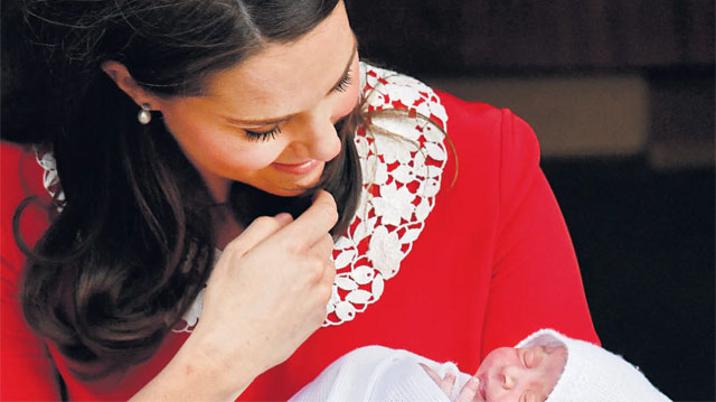
There’s the revered matriarch with her politically incorrect gaffe-prone husband; the slightly dotty eldest son eager to take over the family business; his sons, who have never fully recovered from their mother’s early death, and their beautiful wives. Then there’s the whole extended family including jet-setting brothers, Olympic sportswomen and loose-cannon ex-wives who haven’t quite moved out. It’s the ultimate soap opera.
To judge by the forests felled to bring reports on every episode into our homes, you’d think the nation was completely hooked on The Royals. But are we?
Some 13 million people watched Prince Harry marry Meghan Markle in May (or at least a bit of the coverage), the biggest television audience of the year. That compared with 17.8m for Prince William and Kate’s nuptials, and was less than half the number who watched the princes’ father marry Lady Diana Spencer in 1981.
So, we are fascinated, but not quite as fascinated as we have been. That seems to be borne out by an Ipsos-Mori poll about global views of the royal family conducted in the run-up to the wedding. That found that Prince Harry was by some way our favourite royal, yet only 34% of those questioned were interested in his wedding, against 64% who were definitely not interested.
Tell that to the newspaper editors who produced page after page, supplement after supplement on the event: 230 pages in the Sundays on the day after, 200 in the Mondays. The Mail stable, as ever, led the charge. The Mail on Sunday went straight through from page 1 to page 45 without pausing for breath, while its daily sister mustered a total of 61 pages: the first 29 news pages plus a “sumptuous” 32-page souvenir photo album.
That word ‘sumptuous’ says so much about the Press’s attitude to the family, or at least the white-tops, the Telegraph and the Sun – perhaps not coincidentally the papers that bang the Brexit / patriotism drum most loudly. The vocabulary is old-worldly, deferential, simperingly obsequious. When the Duke of Edinburgh announced that he was withdrawing from public appearances, the Express splashed on the story under the headline, “Thank you sir!” On his last official outing, it put him on the front page again, with the headline, “Thank you, sir”. Never let it be said that it doesn’t know how to play a variation on a theme. The Mail’s interpretation was “Farewell Sir: They don’t make ’em like you these days!” You can almost visualise the forelock tugging.
Photographs of the Cambridge children are invariably “magical”. So magical that in November, the paper offered readers a free Kate’s Cuties 2018 calendar. Two weeks later, Harry and Meghan announced their engagement and the Sunday paper was quick to commission a supply of Magical Royal Weddings calendars.
The Diana effect
It’s all down to Diana, of course. The people couldn’t get enough of her and the papers couldn’t print enough about her. They whipped each other up into such a frenzy that there could never be a happy ending. But neither Press nor public learnt from the experience; neither understood that Diana was a one-off, a never-to-be-repeated phenomenon. Even given her final tragedy, there has been no let-up, beyond an enforced disdain for long-lens snatch shots.
Kate is always “caring”, but the papers are rather less so in giving her and her family space or respite from scrutiny. Pippa Middleton has never been forgiven for having a spectacular bottom that took some of the attention from her sister on her wedding day, so that her own activities – and those of her in-laws – are now regarded as being of public interest and fair game.
Far from there being a reduction in the Press obsession since Diana’s death, it has multiplied. On the day after that Paris car crash, The Times gave over the first half of its news section to the story. That seemed extraordinary at the time, but not in retrospect. It was, after all, one of the biggest news stories of the last century. These days, a woman has only to have her third child for the Mail to clear the front half of the paper and set the supplement presses rolling.
The Daily Telegraph, which describes itself as “Britain’s best-selling quality daily” and is one of only two broadsheets left on the newsstand, gave over the whole of its front page to the birth of Louis in April. It did the same for George, but he should one day become King, if all goes according to plan. So did the Sunday for Charlotte – but it was the weekend and there was a slight constitutional aspect in that she would not lose her place in line to the throne to any younger brother. But on a day when a home secretary was struggling to contain the Windrush scandal and keep her job, a “quality” newspaper thought the most important news event – the only important news event – was the birth of a child whose significance to the country as a whole will be roughly equivalent to that of Prince Edward. No other subject got a look in: the banner across the top that might have imparted some real news was used to advertise an eight-page supplement on the arrival.
Is this quality journalism or what the readers want?
Stuck in the past?
Former Mirror editor Roy Greenslade, a man who doesn’t hide his republican leanings, thinks the printed Press is stuck in the past and is marching hand-in-hand with the monarchy to a shared doom. Writing after the Meghan wedding, he predicted that both would be gone by 2040.
Greenslade accuses the pops of spending months manufacturing synthetic public excitement about the wedding – “a media-confected event” – through “fawning fascination, carping criticism, preposterous speculation and the elevation of the trivial to an implausible level of significance”.
The Mail certainly found itself in a quandary over what to make of Meghan: a divorced American television actor of mixed race. English rose Kate with her impeccable middle-class background (the sort of “middle-class” that can run a £5m family home) was so much simpler.
Meghan – like Sarah Ferguson before her – was a “breath of fresh air”. But, again like Fergie, she had a past that she “might regret”, and while the news pages were filled with gushy guff, there were Sarah Vine and Jan Moir to lend a bit of ballast: “Yes, they’re joyfully in love. So why do I have a niggling worry about this engagement picture?”, “Sorry to be a party pooper, but I’ve now got TEN niggling questions about this wedding”, “Does Meghan need to be SO huggy wuggy?”
And worst of all, how dare she give an interview to Vanity Fair? Presumably, it would have been fine if she’d opened her heart to the Mail, but she chose instead an American magazine. Cue a leader saying you can’t ask for privacy and then talk about your private life, an op-ed by Max Hastings on his worries over this “vulgar Hollywoodising of the young royals”, and a column by Vine likening Ms Markle to Kim Kardashian and accusing the young royals of seeking to turn the House of Windsor into a reality TV show: Keeping up with the Kensingtons.
This last was puffed on the front with the heading, “As Meghan gushes over her love for Harry, will the royals regret turning into a soap opera?” Illustrated, naturally, with a glamorous photograph of Ms M with her leg peeking through a strapless evening gown.
Who is doing the gushing? And who has created this soap opera? In the past year, the Mail newspapers have run 60 front-page photographs featuring members of the royal family (not counting Pippa, Meghan’s father and other long-distance relatives), there have been 34 supplements and pull-outs ranging from four to 32 pages, six Weekend specials of up to 27 pages, 16 events warranting four or more news pages, and more than 25 double-page spreads.
In the weeks surrounding the twentieth anniversary of Diana’s death, there was a series of daily supplements on her “style legacy” including how she made “swimsuits sexy” (hadn’t they heard of Marilyn Monroe?), what her power suits really meant and the diamonds that were her “best friends”.
We have been treated to countless “unseen” and “intimate” photo albums and “secret diaries” featuring Diana or Meghan, and followed George (His Royal Shyness) and Charlotte (Princess Poppet) on their first days to school and nursery.
In early May, the paper REVEALED Meghan’s £100,000 wedding dress. Except it got both the design and the designer wrong. The next day, she was “the most powerful woman in fashion” and the day after that, she had “a £20k addiction to sexy shoes”.
No detail is too small to bother with, no “story” too trivial: though it’ll be a long time before anyone beats the puff from March demanding: “Why are Kate’s fingers all the SAME length?”
They aren’t. But if they were it would show her caring side, her ability to empathise and see things from the other person’s perspective.
Bread & circuses
Are people really bothered about any of this? Does it reflect public interest? Does it help circulation? Do people keep all these “souvenir” supplements in the attic to show their grandchildren? Or is it, as one tabloid journalist suggested, a distraction from key issues – notably Brexit – a way of sustaining the establishment and keeping the lower orders in line, a modern-day bread and circuses?
That Ipsos-Mori poll found that 45% of British respondents were interested in the family and 53% were not.
When it asked people if they had a favourable or unfavourable impression of the family as a whole and calculated a “net” rating by subtracting the one from the other, the British verdict came out as a 32% positive rating. But Romania, Saudi Arabia, India, Malaysia and Hungary felt more warmly towards them. Of the 28 nations polled, only Spain and Argentina registered a negative.
When it came to individuals, William had the most favourable ratings around the world, although Harry, at 55%, pipped him for the top slot at home. Their father had negative ratings across Europe, Canada and Australia – which may not augur well for his future as head of the Commonwealth – and scored only plus 2% at home. The Queen was just behind her grandsons on plus 49%.
What about the commercial imperative? ABC circulation figures do not support the notion that the royals sell papers. There was no perceivable difference in month-on-month sales after the Harry and Meghan engagement and in the same two months the previous year.
The wedding itself may have brought a boost, however. Several of the Sundays showed healthy April-May gains this year, where there had been a drop last year. But the impact on daily sales – if any – was imperceptible. The Mail lost 0.9% month-on-month, compared with 0.75% the previous year. The Sun’s dip was slightly shallower than last year’s. The Mirror lost a lot fewer sales, the Star lost a lot more.
Maybe it just comes down to habit, the herd instinct, an attempt to cling to the dwindling band of older readers who still buy newspapers – and a desperate quest for the elusive “Diana effect”.
Who sells, who doesn’t
Former Sun deputy editor Fergus Shanahan has seen that at first-hand and he thinks today’s editors are on a wild golden-goose chase. This is his assessment of the saleability of today’s royals:
“Diana was a sales phenomenon: we regularly got an uplift of 100,000 for a page 1 bikini picture. Fergie also sold well – especially when having her toes sucked.
“Harry shifted papers a few times and his Meghan romance has sold a bit, although not as much as Fleet Street hoped or expected. Beyond that, forget it!
“William has never sold papers. We did buckets on his 21st, expecting a huge day, and sales slumped.
“People like Kate, but there’s no Diana factor. The Queen is respected, but shifts no copies.
“Minor royals – Beatrice and Eugenie, Andrew and Edward – antagonise readers, who see them as freeloaders. No sales there.
“Nor do I see the new crop of babies selling much, certainly not enough to justify the endless souvenir picture pullouts, especially when these are not glossy but just plain old newsprint. After all, the pictures are freely available on any device.”
This assessment not only reflects the levels of individual popularity found by Ipsos-Mori, but also the number of appearances the various royals make on our front pages. William, for example, hasn’t featured on page 1 of the Mail at all in the past year – he didn’t even make the front when Louis was born or when he visited Jerusalem last month. And Charles has appeared only in a negative context: “The pampered self-pitying petulant prince” and “Why hasn’t Charles met his new baby grandson yet?”
Which brings us back to the question: Why do it?
Back to Shanahan: “To hang on to older readers still interested in royal doings. These are the flag-wavers who queue at Sandringham and Windsor: lifelong newspaper buyers who still think all our royals are marvellous. These are the only people likely to put that 16-page souvenir of baby Louis in the loft to gather dust. These are readers whose parents likewise weighed down their floorboards with souvenir editions – VE Day, the Coronation, Charles and Diana’s wedding.
“With sales in freefall, London editors will do anything to hang on to these dependable oldies a bit longer. When you are dropping 10% or more a year, every copy counts.”
A strategy born of desperation then. And if the royals won’t save them, what will?
“They’d be better off saving expensive newsprint and rethinking their purpose,” Shanahan says. “Cheaper, newsier papers might sell better than overblown, unwanted, royal baby brochures.”










